Home » Hunting Dogs » Spring Woodcock: The Quiet Period and Pointing Dog Training
Spring Woodcock: The Quiet Period and Pointing Dog Training
- Check your local laws and rules for "quiet period" dates before training on spring woodcock and exercise ethical judgement on ending your season early in the rare case of contacting nesting birds.
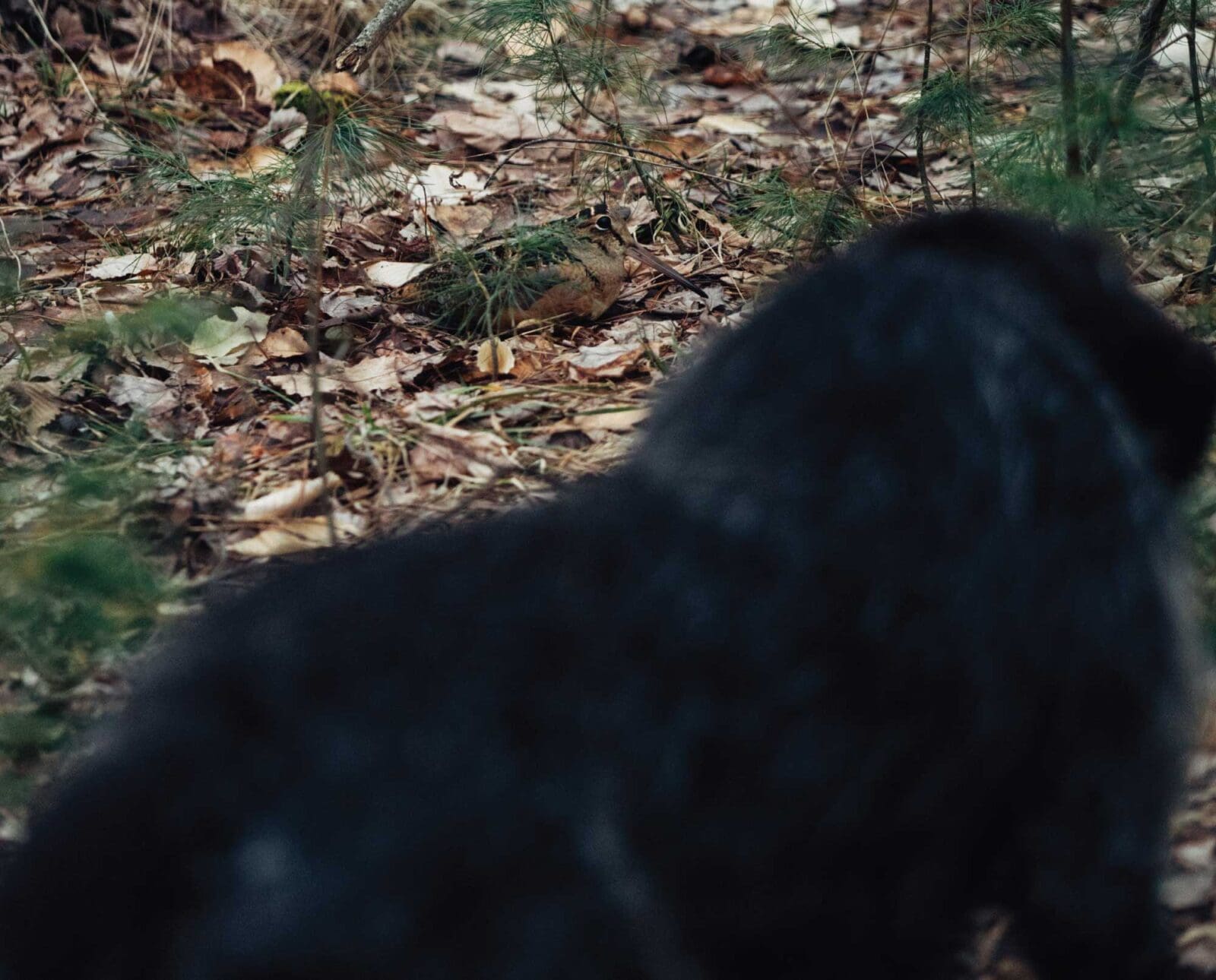
A.J. DeRosa, founder of Project Upland, is a New England…
Explore the ethics, laws, and dog training opportunities of the spring woodcock season
The afternoon sun sat low through the thick cover. It glistened off the saturated ground, small patches of snow still pushing back against the oncoming spring.
The sound of my Wirehaired Pointing Griffon’s bell came sharply through the undergrowth, occasionally muted by the splash of water as Grim worked his way back and forth. We had been through this cover multiple times in the past week with no signs of life in the way of game birds. My mind wandered, thinking of how exciting it will be to have American woodcock back on our doorstep after their migration from wintering in the South.
Listen to more articles on Apple | Google | Spotify | Audible
My Garmin Alpha suddenly vibrated; Grim was on point 70 yards ahead. I plotted my path forward dodging branches, ignoring the deep puddles with my Muck boots, and eventually spotting him still as a statue. His tail stood motionless, his expression intense; all sure signs that the scent coming down the wind was signs of life. The woodcock was not 5 feet off his nose, and, as it flushed into the air, I was proud to see Grim’s maturity in the face of all this excitement after a long winter of no birds. The date was March 17; the woodcock were back in New Hampshire.
Spring woodcock represent a unique opportunity for wild bird exposure. This bird of many names present layers of complexity from a dog’s understanding of habitat to the unique scenting conditions that cannot be replicated with pen-raised birds. Spring woodcock migrations, along with late summer days after the quiet periods, offer great training opportunities for pointing dogs. This includes everything from exposure to putting the finishing touches and tuning up steady training.
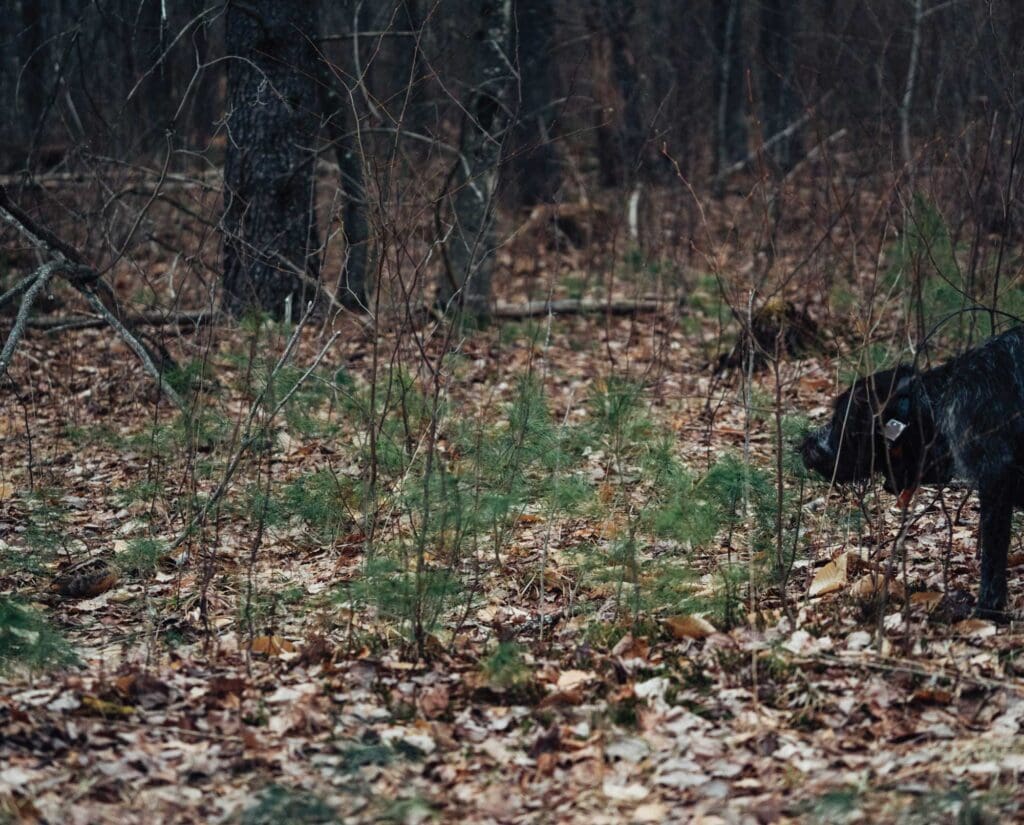
The controversy of spring woodcock training
While some newer folks may find it surprising, the debate over running dogs on spring woodcock is long standing, aggressive, and subject to a lot of opinions. So goes the world of game management. We all want science-based management until we disagree with the science, then the public forum turns into what social media is these days.
There are certainly some ethics at play when running dogs, shooting shots, and engaging in game birds that always need consideration, no matter the season. Many debate that a late ruffed grouse season with limited food sources are a death sentence to birds that get away, and many states’ seasons reflect that theory. While others, with far older and less popular upland hunting populations, seem to operate as if we are in grouse covers from the 1950s.
American woodcock represent a unique example of a migratory bird that shows very little body mass weight loss in migration compared to other species. In fact a study in 1954 showed woodcock only lose 10% of their peak fall weight durning the fall woodcock migration. (Sheldon 1971).
No matter where you stand, it’s a serious subject and does deserve earnest considerations, understanding of your local laws, and knowing a true nesting contact and how these encounters are prevented with timing. Despite the laws and ethics at play, someone in the world of social media is running dogs during quiet periods. We, as a community, should do our best to reach out to those individuals to stress both the ethical and legal implications. It is worth noting that quiet periods are not unique to woodcock; they apply to all birds and even big game.
The history of spring woodcock
For those who have read the New England classic Woodcock Shooting by Edmund Davis, published in 1908, it’s hard to forget the unusual and candid opening. Davis describes the world from the point of view of a spring woodcock migrating North. In its travels it soon finds itself off the nose of an English Setter and eventually hunted; yes, hunted.
Davis was rather vocal about how it should be illegal to hunt woodcock in the springtime, and his dramatic depiction in the intro of the book shows the common juxtaposition of our relationship with our query—something non-hunters never seem to understand. Eventually, the hunting of woodcock in the spring was banned in North America and rightfully so. But the tradition of running dogs for spring training has been maintained. There are even field trial events in the country that state DNRs allow in the beginning of the quiet period by special permit, testament to the low-impact training opportunity.
The importance of the quiet period
For those new to the world of wild birds and bird dogs, it is important to understand that the running of dogs on any wild bird in the spring is regulated. And that regulation is not an afterthought—it’s founded in science.
For those of us wild-bird snobs, it’s a very short training season depending on what state you live in. Additionally, the “quiet period” is legally mandated for training activities protecting nesting birds and their young.
“Biologists choose when a quiet period occurs based on when woodcock begin nesting in that area,” said PhD student Colby Slezak who works on the spring banding program in the Department of Natural Resources Science at the University of Rhode Island. “The charismatic aerial courtship flight and call of males or the presence of nesting females is a sign that the breeding season is underway.”
In my home state of New Hampshire, the quiet season runs from April 15 to July 15, and not just for woodcock but also ruffed grouse. The further south you go the sooner those quiet periods begin, again based on data that has shown the breeding routines of these game birds.
When asked about the impact of the running of dogs in the springtime on woodcock before the quiet period, Slezak pointed out that there is not any data to support that idea.
Some want to argue that the increased pressure on the returning birds results in expended energy that has negative impacts on the population. As mentioned, that impact on wintering grouse can certainly be serious as birds use energy to stay warm with limited food to recharge that energy store. Woodcock don’t face such food shortages in the spring, hence why they came back North to their rich hunting grounds to attempt to successfully raise their broods.
The Eastern Woodcock Migration Research Cooperative has identified American woodcock as “itinerant breeders.” Meaning a female will attempt multiple nests in multiple locations due to the low success of ground nesting in their habitat. Dr. Erik Blomberg of the University of Maine said “They have evolved in very ephemeral, young forests habitats, they have long breeding seasons, and the cost of reproduction is relatively low…”
“Quiet periods help protect nesting birds by limiting the potential for an inexperienced dog to grab a hen off the nest or eat the eggs,” Slezak said. “Woodcock hens with nests and broods sit very tight and can be easy to grab. When flushed, the hen performs a predator ‘decoy’ display which involves her feigning injury to lure the predator away from either her eggs or chicks. To a younger or more inexperienced dog this can be quite enticing.”
Slezak is a bit of woodcock and dog-work junky in this world, and his eagerness to get into the field is infectious.
The banding of woodcock with pointing dogs
Pointing dogs are working dogs, and some of that work is conservation based. In the case of banding spring woodcock with the use of pointing dogs, it’s important to note that it’s illegal to run your dog during this time unless your dog is certified by a state and accompanied by biologists. Further, each state has different rules governing how a dog is certified or used and it is up to you as the user to abide by those rules and laws.
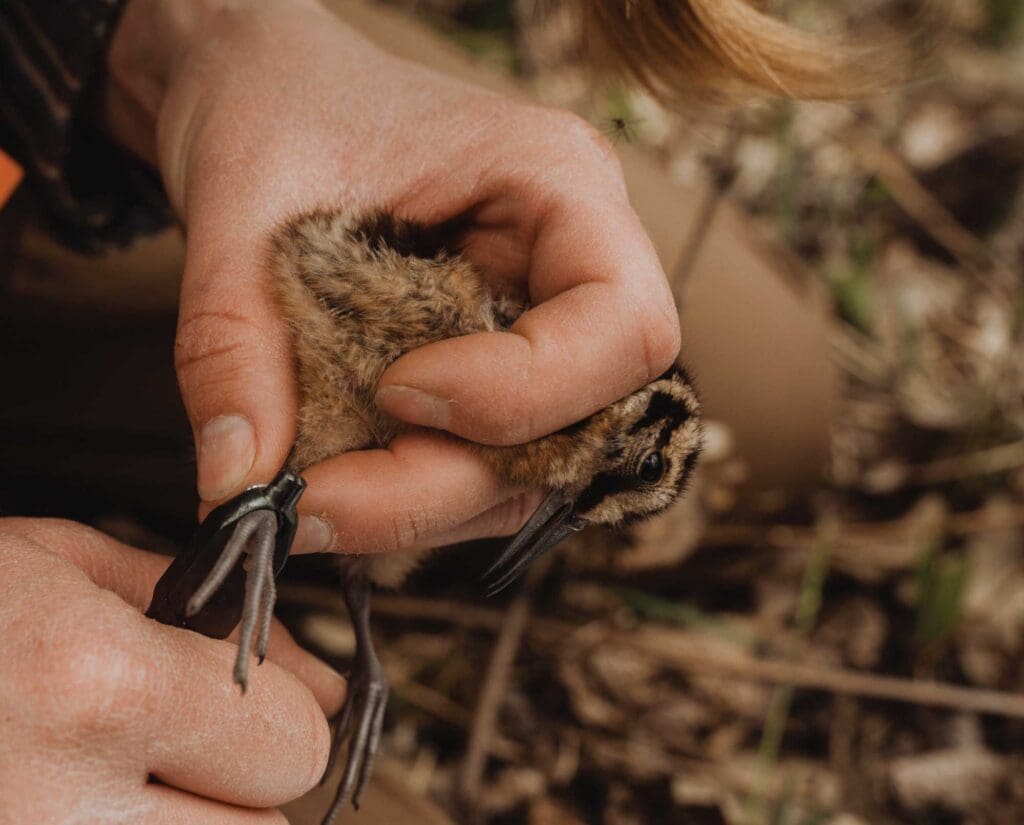
“Biologists that perform nest and brood searches choose dogs from handlers that have trained their dog to be steady to the flush and that hold a staunch point when they come across a bird,” Slezak said. “This ensures the hen is not flushed off of the nest. Biologists are able to tell the bird is nesting from behavior, and, so, cause little disturbance to the nesting bird. If the hen is flushed accidentally by the dog, dogs that are steady to the flush and that hold a staunch point will not be lured or enticed to grab the hen if she begins performing her injury feigning display.
“In Rhode Island dog handlers are accompanied by a university or state biologist. In some other states, dog handlers go through an apprenticeship training with more senior dog handlers.”
For those who want to extend that season further, the opportunity to get your dog involved in these programs is both exciting and good training. You can watch this incredible practice along with Minnesota biologist Bailey Peterson in our film Woodcock Banding – A Behind the Scenes Look at Conservation.
Running your dog on spring woodcock
With a few-week window in sight as the first birds return North, it is an exciting opportunity to give your dog wild-bird exposure. It’s a time when the shotguns stay home and all your focus can be on how your dog performs. It’s enjoyable and your dogs will love you for it.
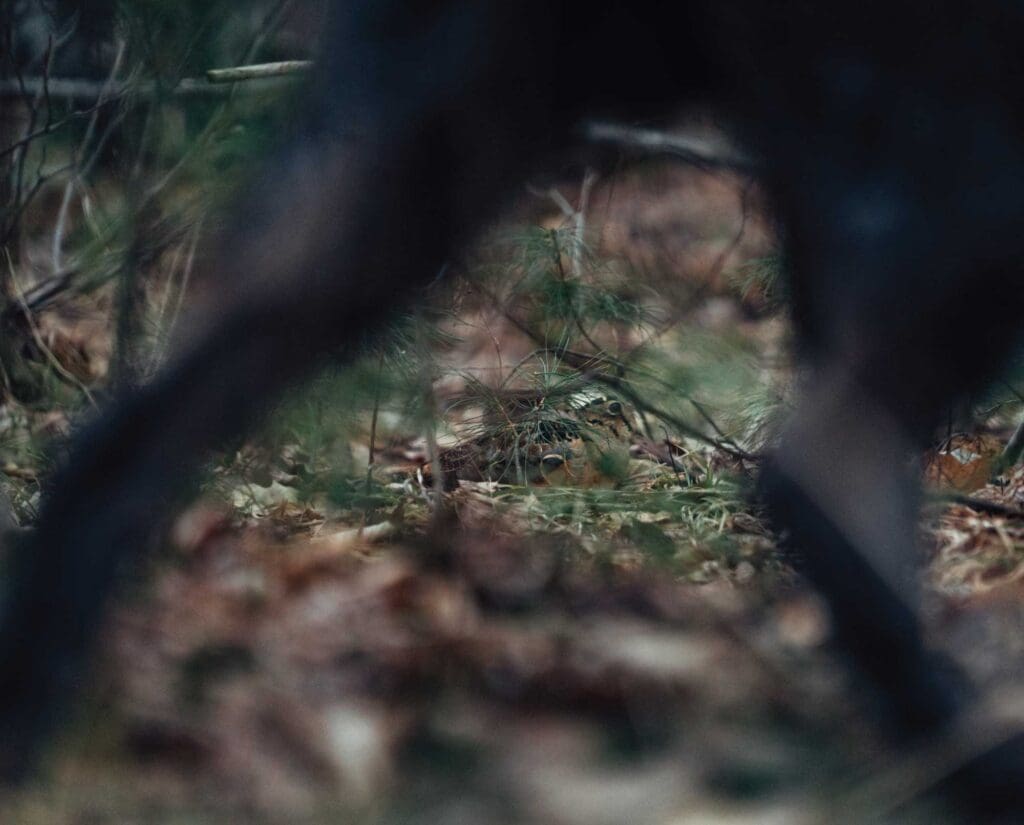
The days those birds begin to flood local covers can change depending on where you live and weather patterns, but, eventually, those “little russet fellows” will be home. As hunters, it’s our responsibility to check our local laws as they pertain to the quiet period and dog training and adhere to them. It’s both the legal and ethical thing to do as people who care about this resource.
In the rare case that you see a hen behave like a nesting bird or happen upon a nest, it’s time to leash up the dog and wait until summer for your next wild-bird training opportunities.
While woodcock in the Eastern flyway experience an annual population decline of 2 percent, we must remember the real threats that exist for the birds we love. Habitat is at the core of the issue, and, particularly in the Eastern flyway, that is exacerbated by high population densities and a lack of woodcock habitat in migration routes. We have the scientific data to solve the problem; what we need is more voices, better funding, and large-scale policy to reverse this disturbing trend. If you are worried about the future of woodcock, as you should be, those are the ways you can help.
A.J. DeRosa, founder of Project Upland, is a New England native with over 35 years of hunting experience across three continents. His passion for upland birds and side-by-side shotguns has taken him around the world, uncovering the stories of people and places connected to the uplands. First published in 2004, he wrote The Urban Deer Complex in 2014 and soon discovered a love for filmmaking, which led to the award-winning Project Upland film series. A.J.'s dedication to wildlife drives his advocacy for conservation policy and habitat funding at both federal and state levels. He serves as Vice Chair of the New Hampshire Fish & Game Commission, giving back to his community. You can often find A.J. and his Wirehaired Pointing Griffon, Grim, hunting in the mountains of New England—or wherever the birds lead them.



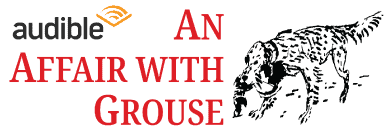
Ok, so your dog points a woodcock. What specifically are you focused on with your training during this Spring period using woodcock? Ask the average dog handler what aspect their trading & get ready for a puzzled look.
I used woodcock to break my dog. Meaning making him fully steady. Being a Griffon, that constant training is very imperative so the wheels do not come off. On top of that exposure to a wild bird you intend to hunt teaches that dog how to hunt it. How close it can get, where they live, and all the things a wild bird teaches a wild bird dog that a pen raised bird never can.